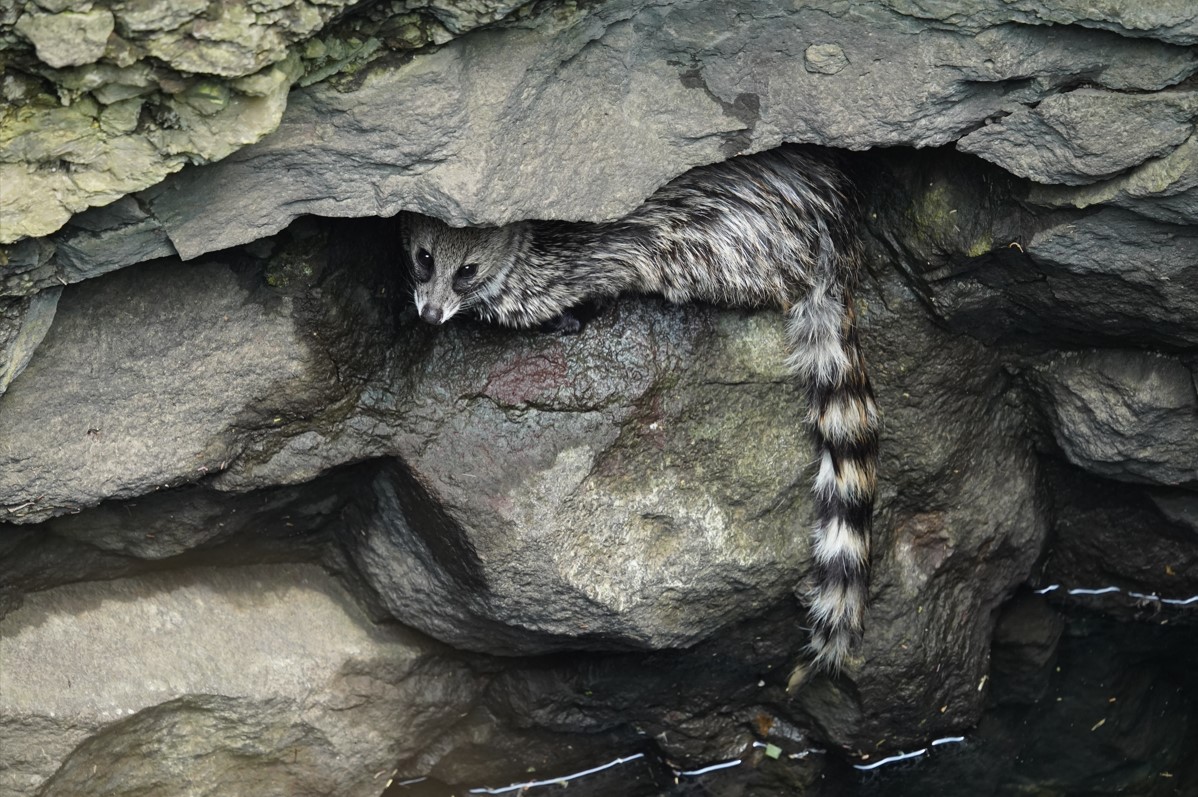Owing to how it is commonly called, the civet cat is often mistaken to be a feline. This “cat-like” species or feliform actually holds a lineage that is closer to mongooses and hyenas. Being omnivorous, civets play a vital role in maintaining ecological balance. Feeding primarily on insects and rodents, they act as natural pest controllers, curbing those populations that pose threats to agricultural crops. Moreover, their involvement in seed dispersal ensures the propagation of native trees in an ecosystem.
Despite coexisting with humans for generations in Asia and Africa, these species find themselves at the brink of localised extinction. Human-civet cat interactions have often been marked by abuse in order to gain monetary benefits in the perfume or coffee industry. Additionally, anthropogenic pressures such as habitat fragmentation and poaching further exacerbate conflict.
‘Civet’ from Civets
Civet cats have been tortured for the perfume industry, where secretions from glands located in their anal region, known as ‘civet’, are extracted and used as a fixative in perfumes. While it has a distinctive odour of musk, these secretions are essential to civet cats in the wild for marking territory and attracting mates.
The first use of ‘civet’ or musk dates back to ancient history when it was reportedly presented as a gift to King Solomon by the Queen of Sheba (1013-982 BC) when she visited him in Jerusalem. As archaic as the practice is, the methods of capturing and handling of civets to collect musk continue to remain brutal till date.
Primary supply of civet musk for global export comes from Ethiopia that has a history of trading it to the perfume industry. A report released by the World Society for the Protection of Animals in 1999 shockingly exposed the horrific manner of handling civets to procure musk. Civets hunted from the wild are kept in cramped, unsanitary cages, and the perineal gland located in their posterior is squeezed to extract the musk it produces. Given how the practice of trading civet musk is age-old, it continues to take place with neglect to the animals’ overall condition.
Growing awareness has led to condemnation of the cruelty involved in obtaining ‘civet’ or musk for perfumery. Animal welfare organisations and ethical perfume companies have campaigned against the use of this musk in perfumes, and have advocated for synthetic alternatives or plant-based substitutes that mimic the scent of civet. Though the aspect of keeping civets in captivity for their musk is controversial, the practice continues to persist covertly.
Civets and Coffee
Another instance where civet cats have been abused at the hands of humans is in the production of kopi luwak. Often touted as the world’s most expensive coffee, kopi luwak, which originated in Indonesia, is crafted from coffee berries that have been consumed and excreted by civets. Despite its origin in faeces, it is celebrated for its smooth, caramel-like taste. However, animal welfare groups have time and again flagged the mistreatment civets face in its production process.
Civets are captured from their natural habitats and are confined within solitary cages. Now deprived of the freedom to obtain nourishing fruit from trees in the wild, they are forced to consume a diet of coffee berries in excessive quantities instead. The beans released in their excretion are laden with gastric juices and enzymes from the civet cat stomach, which contains an exotic taste. Washed and roasted, it is traded as kopi luwak, or civet coffee. What is overlooked is that the harsh captivity of arboreal civets makes them suffer from nutrition deficiency and poor health. Despite some retailers market the product as being sourced from free-roaming animals, these claims are highly suspect owing to the large-scale sale and premium popularity of this product.
Civets and Poaching
Civet cats are also poached from the wild for meat and traditional medicines. In certain cultures, civet oil, derived from the anal glands of civets, has been used in traditional Chinese medicine for its purported medicinal properties. Additionally, civet fur is also traded to make clothes, accessories, and decorative items. The demand and supply chain for such products has led to severe exploitation of civets.
Civets and Habitat Fragmentation
India shelters distinct species of wild civets: Asian palm civet, small Indian civet, large Indian civet, Malabar large-spotted civet, small-toothed palm civet, masked palm civet (Himalayan palm civet), and brown palm civet (Jerdon’s palm civet). Listed as Critically Endangered by the IUCN, Malabar civets are protected under Schedule I of the Wildlife (Protection) Act of 1972, while the rest are slotted under Schedule II of the Act. Deforestation and habitat fragmentation from activities like logging, agriculture, and urbanisation have stripped civets from their once lush homes. Furthermore, shrinking forests have dwindled the prey populations for this omnivorous species. Desperate for food and shelter, they now lean on human settlements, which leads to unexpected encounters and conflict.
With Wildlife SOS’s Rapid Response Unit receiving multiple calls of unusual sightings, rescues of civet cat species have been undertaken in urban areas such as a shoe factory, a hotel and educational institutes. Along with this, one more threat haunts animals in the wild — open wells. Wildlife SOS has retrieved civet cats and other animals from perilous situations after they accidentally fell into deep, uncovered wells.
The urgency to transform the narrative of human-civet interaction from cruelty to compassion cannot be overstated. The exploitation of civet cats by humans paints a grim picture of our own species, one that is difficult to redeem. However, amidst this stark reality, Wildlife SOS strives to incorporate a positive tone by mitigating the repercussions of habitat fragmentation on civet cats.
If you encounter a civet cat in distress, please reach out to the nearest forest officials or contact our 24-hour helpline. Wildlife SOS operates round-the-clock emergency rescue hotlines in four regions:
– Delhi NCR: +91-9871963535
– Agra and Mathura, Uttar Pradesh: +91-9917109666
– Vadodara, Gujarat: +91-9825011117
– Jammu and Kashmir: +91-7006692300, +91-9419778280





